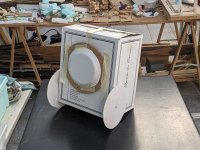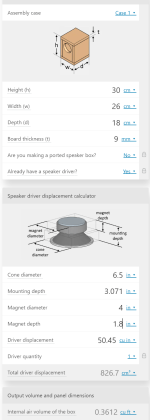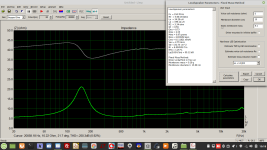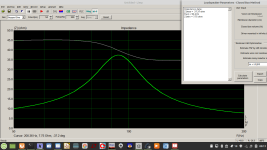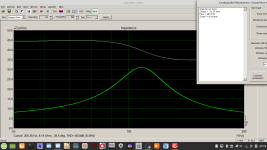Do you really require two inputs?
You would only need two inputs if you wanted to plug in two instruments and to adjust their relative levels.
An alternative to the stereo amp with its own integrated tone controls is a mono amp fed from a separate preamplifier with its own tone controls. The preamp can be stereo, but with only one of its channels in use.
I may return with links to suitable modules.
You would only need two inputs if you wanted to plug in two instruments and to adjust their relative levels.
An alternative to the stereo amp with its own integrated tone controls is a mono amp fed from a separate preamplifier with its own tone controls. The preamp can be stereo, but with only one of its channels in use.
I may return with links to suitable modules.
I'm at a disadvantage in not knowing what suppliers you have access to in the USA.
I've looked again, but I'm afraid I can't come up with a better suggestion for a ready-assembled amp with tone controls than the one I made previously.
If you can forego the tone controls, you could use a TDA2050 mono module like this: https://www.amazon.co.uk/Folewr-TDA2050-Amplifier-5W-120W-1-Channel/dp/B094MJL919/ref=sr_1_6?crid=380T5XWQJRX8G&keywords=mono+amplifier+module&qid=1683208011&sprefix=mono+amplifier+modul,aps,287&sr=8-6
It should be capable of outputting somewhere around 10 W on 12 V DC depending on speaker impedance.
I've looked again, but I'm afraid I can't come up with a better suggestion for a ready-assembled amp with tone controls than the one I made previously.
If you can forego the tone controls, you could use a TDA2050 mono module like this: https://www.amazon.co.uk/Folewr-TDA2050-Amplifier-5W-120W-1-Channel/dp/B094MJL919/ref=sr_1_6?crid=380T5XWQJRX8G&keywords=mono+amplifier+module&qid=1683208011&sprefix=mono+amplifier+modul,aps,287&sr=8-6
It should be capable of outputting somewhere around 10 W on 12 V DC depending on speaker impedance.
Oh yes, I remember now you said Portugal!
I read that Amazon doesn't have a warehouse in Portugal: https://www.portugalist.com/amazon-portugal-shipping/
Amazon.es (Amazon Spain) is said to be the best option.
Half the residents of Glasgow are on the fiddle! 😀
I read that Amazon doesn't have a warehouse in Portugal: https://www.portugalist.com/amazon-portugal-shipping/
Amazon.es (Amazon Spain) is said to be the best option.
The violinist studied at RCS in Glasgow 🙂
Half the residents of Glasgow are on the fiddle! 😀
Here is the Amazon Spain TDA2050 equivalent: https://www.amazon.es/Amplificador-LiebeWH-Altavoz-Amplificación-Potencia/dp/B09P43HWCJ/ref=sr_1_1?__mk_es_ES=ÅMÅŽÕÑ&crid=2GEA6GTIRM2SH&keywords=TDA2050+mono+amplifier+module&qid=1683218675&sprefix=tda2050+mono+amplifier+module+,aps,140&sr=8-1
The amp is not class D so expect a high current draw. However, you should be OK with your desired battery pack and high sensitivity speaker.
From the UK, you could consider: https://quasarelectronics.co.uk/Item/cebek-e-2-mono-audio-power-amplifier-module-5w-rms
You would add a 47K logarithmic potentiometer using shielded cable as described and illustrated in the PDF: https://quasarelectronics.co.uk/media/ecom/prodpdf/cebek-e-2-user-manual.pdf
The UK option would be my preference - simple, less current hungry and not much of a risk at the price!
The amp is not class D so expect a high current draw. However, you should be OK with your desired battery pack and high sensitivity speaker.
From the UK, you could consider: https://quasarelectronics.co.uk/Item/cebek-e-2-mono-audio-power-amplifier-module-5w-rms
You would add a 47K logarithmic potentiometer using shielded cable as described and illustrated in the PDF: https://quasarelectronics.co.uk/media/ecom/prodpdf/cebek-e-2-user-manual.pdf
The UK option would be my preference - simple, less current hungry and not much of a risk at the price!
Thanks ! Which amplifier are you using ? I am starting to shy away from using a tool battery pack, and would like to instead build my own battery pack with a BMS and either four, five, eight, or ten 18650 batteries. I am trying to understand the difference between 14.7V and 18.5V when it comes to speaker and amplifier performance.for your inspiration - this is my actual mobile amp
And then...what type of charger might work with each. Can I put 18650's inside and then have a plug (like a laptop power supply) on the outside to charge them, without it being too much of a fire hazard? Trying to figure out the best way to do this.
Thanks !
The amp and all other pcb-modules are designed from scratch be me.
The power class-D module is based on TI TPA3118, my tiny working horse.
To avoid a BMS, I use 4 single 18650-Lion-accus in a 4 slot battery holder.
They are charged in an off-the shelf 4-slot charger XTAR VC4SL - no need to invent the wheel another time.
This is a secure method avoiding fire hazard by inappropriate DIY charging circuits.
For protection I added an undervoltage lockout circuitry as well as a watchdog which disconnects after 15min sound pause.
Charging each cell in its own slot makes BMS superflous.
And all my 18650 cells are salvaged from old accupacks giving them a second life.
Depending on your power level, one discharge cycle is in the ballpark of 10 hrs.
The power class-D module is based on TI TPA3118, my tiny working horse.
To avoid a BMS, I use 4 single 18650-Lion-accus in a 4 slot battery holder.
They are charged in an off-the shelf 4-slot charger XTAR VC4SL - no need to invent the wheel another time.
This is a secure method avoiding fire hazard by inappropriate DIY charging circuits.
For protection I added an undervoltage lockout circuitry as well as a watchdog which disconnects after 15min sound pause.
Charging each cell in its own slot makes BMS superflous.
And all my 18650 cells are salvaged from old accupacks giving them a second life.
Depending on your power level, one discharge cycle is in the ballpark of 10 hrs.
Last edited:
@bucks bunny wow! That's running the B&C 6XT13? If so, good to hear that I could get away with four 18650's. Thanks.
https://www.google.com/aclk?sa=l&ai...EwjZ47LG94v_AhVEkeYKHd2FBfgQvhd6BAgBEFQ&nis=8
Something similar to this with USB slot sells for about $7 here, you can think of something like this as a useful device.
Saw it on a cart, looping message was potatoes so much per kilo....! Saved the vendor from attracting attention by shouting.
Something similar to this with USB slot sells for about $7 here, you can think of something like this as a useful device.
Saw it on a cart, looping message was potatoes so much per kilo....! Saved the vendor from attracting attention by shouting.
Notwithstanding everything posted above, I went about a very similar requirement, a different way.
(NB - not for busking, just for ease of transport/ flexibility)
I've had Steinberger Wav4 upright bass since they came out, and a P-bass a few years now, and I pair those with a Roland BassCube: a brilliant little thing, pretty much all I want for practice at home or elsewhere.
So - rather than 6 AA batteries - I use a 20000mAH Anker USB battery bank, and a USB plug input buck/boost converter board (from you know where) to generate +9.6v... and wired a short lead with the right 5mm DC plug to match the Roland 9v supply input socket (note for all - Roland usu are Centre -VE).
The result is silent (my Wav has piezo pickups, and the high input Z is v. sensitive to supply-side noise - any kind of mains -powered supply inc diy very linear adds much hummmm) It goes way louder than I'll likely need with either instrument; and lasts indefinitely; proved reliable, too / charge anywhere, anytime.
And the solution works just the same for my old acoustic guitar mag pcikup into its Roland cube practice amp, too.
Just a thought.
(NB - not for busking, just for ease of transport/ flexibility)
I've had Steinberger Wav4 upright bass since they came out, and a P-bass a few years now, and I pair those with a Roland BassCube: a brilliant little thing, pretty much all I want for practice at home or elsewhere.
So - rather than 6 AA batteries - I use a 20000mAH Anker USB battery bank, and a USB plug input buck/boost converter board (from you know where) to generate +9.6v... and wired a short lead with the right 5mm DC plug to match the Roland 9v supply input socket (note for all - Roland usu are Centre -VE).
The result is silent (my Wav has piezo pickups, and the high input Z is v. sensitive to supply-side noise - any kind of mains -powered supply inc diy very linear adds much hummmm) It goes way louder than I'll likely need with either instrument; and lasts indefinitely; proved reliable, too / charge anywhere, anytime.
And the solution works just the same for my old acoustic guitar mag pcikup into its Roland cube practice amp, too.
Just a thought.
Thanks ! do you by chance know the measurements and internal volume of your enclosure ? is it ported ? I would like my amp to be pretty small--with batteres and amplifier board inside--but I'm starting to think I will have to increase the size. Right now it is 30cm x 26cm x 18cm...on the outside, and the wheels are going to be fatter and in Thanks !4x 18650 exactly 🙂
Attachments
This driver does not need much volume. The size of your enclosure comes close to mine depicted in #27 and should do the trick.
Hi all ! Thank you for following along in this saga - Here are my current questions :
Box volume :
Volume calculator i've been using : diyaudioandvideo.com
Here are the speaker specs (data sheet) :
Effective cone size : 6.5"
Equivalent Volume (Vas): .25ft3
Free Air Resonance (Fs): 98 Hz
Total Q (Qts): 0.6
Qes 0.7
If I put in Qtc of 0.707 (the default value), I get an ideal cabinet size of 0.64 cu. ft.

If I put in Qtc = 0.78, I get a box size of 0.36 cu. ft., which is closer to the size I'd like for portability's sake. f3 and fb barely change. I don't know what would change with a cabinet half the size.

Voltage :
I am going to try to make a battery pack with four 18650's (3300mAh) or four 21700's (4000mAh) and a 4s 18650 BMS.
Should I get protected batteries if I am using a BMS ?
Will 16.8V be enough for this puppy? What advantages would a fifth cell bring? Thanks !
Power supply :
I am thinking about using a 16.8v charger from amazon. If there was a way to use a power cable plugged into the outside of the amp that might be even better. Is there an easy way to get that 220V to the 16.8V for the BMS ? More of an electrical component to go between the 220V and the BMS than a conventional "charger" with a plug and cable.
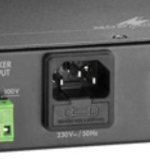
Box material :
I was thinking using using styrofoam roofmate for three of the sides and covering it with surfboard fiberglass laquer to keep it ultralight, but since it will be on wheels, perhaps the weight doesn't matter so much. I was think of using baltic birch for the other three sides, but again, I have no idea what's best and am open to suggestions !!
Thank you again for all your help !!
-Nick
Box volume :
Volume calculator i've been using : diyaudioandvideo.com
Here are the speaker specs (data sheet) :
Effective cone size : 6.5"
Equivalent Volume (Vas): .25ft3
Free Air Resonance (Fs): 98 Hz
Total Q (Qts): 0.6
Qes 0.7
If I put in Qtc of 0.707 (the default value), I get an ideal cabinet size of 0.64 cu. ft.
If I put in Qtc = 0.78, I get a box size of 0.36 cu. ft., which is closer to the size I'd like for portability's sake. f3 and fb barely change. I don't know what would change with a cabinet half the size.
Voltage :
I am going to try to make a battery pack with four 18650's (3300mAh) or four 21700's (4000mAh) and a 4s 18650 BMS.
Should I get protected batteries if I am using a BMS ?
Will 16.8V be enough for this puppy? What advantages would a fifth cell bring? Thanks !
Power supply :
I am thinking about using a 16.8v charger from amazon. If there was a way to use a power cable plugged into the outside of the amp that might be even better. Is there an easy way to get that 220V to the 16.8V for the BMS ? More of an electrical component to go between the 220V and the BMS than a conventional "charger" with a plug and cable.

Box material :
I was thinking using using styrofoam roofmate for three of the sides and covering it with surfboard fiberglass laquer to keep it ultralight, but since it will be on wheels, perhaps the weight doesn't matter so much. I was think of using baltic birch for the other three sides, but again, I have no idea what's best and am open to suggestions !!
Thank you again for all your help !!
-Nick
Attachments
Generally these simulations are nice in theory but do not expect that practical results match closely. The elephant in the room is fs, that in reality never is as low as stated in the data sheet. This is a problem due to the suspension, B&C claim that the do their measurements after some "burn in". That is the impedance curve and calculated T/S parameter with one of my 6XT13 drivers out of the box.
Attachments
- Home
- Amplifiers
- Solid State
- Building my first amp, a battery powered busking speaker
